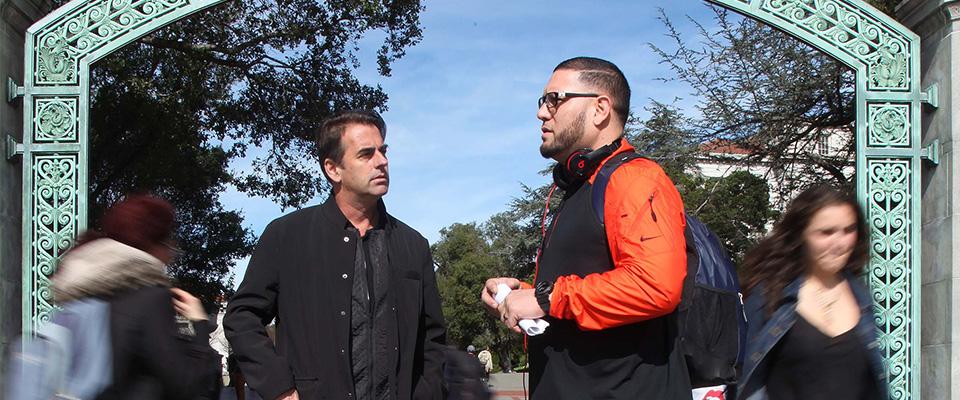A task force commissioned nine months ago by UC Berkeley Chancellor Nicholas Dirks to improve the poor academic performance of many of Cal’s student-athletes presented its findings and recommendations at a press conference last Friday.
The Chancellor’s Task Force on Academics and Athletics was created in January after an NCAA report revealed abysmally low graduation rates for Cal’s football and men’s basketball teams. Only 44 percent of football players admitted between 2003 and 2006 graduated within six years of enrollment, placing the Bears dead last among the 72 programs in the BCS conferences. During that same span, the men’s basketball program graduated just 38 percent of its athletes—the lowest percentage in the Pac-12.
Needless to say, the figures were an embarrassment for a campus that prides itself on its academic reputation and which is generally hailed as the top public university in the world.
Sitting in front of the media on Friday, Cal interim athletic director and task force member Mike Williams opened the press conference by acknowledging the challenges ahead. “Great institutions stay great by being willing to ask very difficult questions of themselves and then being willing to act on the answers to those questions,” he said.
Williams, a former Cal athlete himself, took over for Sandy Barbour, who stepped down this summer after ten years at the helm of Cal Athletics.
The task force’s report lists 54 recommendations in all, including integrating athletes and non-athletes in residence halls, eliminating or reducing the number of mid-week competitions, and making more academic majors accessible to athletes whose schedules often conflict with course offerings and lab hours.
While the task force has recommended slightly increasing SAT and GPA standards for prospective student-athletes, they resisted setting any specific “floors” for acceptance to the University. At the press conference, the speakers instead stressed the importance of maintaining a “holistic” approach to admissions, one that also takes into account “non-cognitive” factors such as determination, motivation, and focus.
Incoming freshman admitted to Cal in 2014 have an average GPA of 4.18 and SAT test scores approaching or exceeding 700 (out of a possible 800) in each of the three categories: Critical Reading, Math, and Writing.
One proposal from the task force would allow admission to be offered to prospective student-athletes with SAT scores as low as 400 and GPAs as low as 2.5.
On the teams the task force studied, only 38.6 percent of students admitted with high school GPAs below 3.0 managed to graduate. Similarly, the task force found that student-athletes who scored below 500 on the verbal portion of the SAT graduated at a far lower rate (48.9 percent) than those who scored above 500 (72.6 percent).
Professor Panos Papadopoulos, one of several faculty members on the task force, nevertheless insisted that admissions were not the root of the problem. “Even if we did not move one inch on how we do admissions today for student athletes,” Papadopoulos told the assembled press last Friday, Cal would not have had a problem with graduation rates going forward at anything like the “magnitude of previous years.”
One change to admissions protocol that will go into effect: Student-athlete admissions will no longer be considered as an entirely separate class, but will be grouped with other applicants with “special talents,” such as musicians and artists.
The task force’s first recommendation has already been implemented. Athletics will now report directly to Chancellor Dirks instead of to the Vice Chancellor for Administration and Finance John Wilton, as was previously the case. Dirks gave assurances that the University will act upon “each and every one” of the recommendations made by the task force.
One word repeated throughout the press conference was “integration.” The task force found that many student-athletes feel alienated from their non-athlete campus mates and vice versa. Recommendations for addressing the problem ranged from integrated mandatory orientations to mixed residential living arrangements.
Most of the recommendations are expected to be implemented this academic year and already this fall athletes were instructed by Athletics Director Williams to attend Convocation with the rest of their classmates.
The task force also made it clear that it was, “exceptionally troubled by the Pac-12 Network’s scheduling practices that have led to mid-week competitions, especially those involving travel.” In the upcoming men’s basketball season, the Bears will travel to mid-week contests on three occasions during the spring semester. While noting the importance of the revenue generated by televised games, Dirks was optimistic that the problem would be ameliorated in future negotiations with the conference.
In the meantime, the stated goal for each athletic team at UC Berkeley is a graduation rate of 91-92 percent—on par with the general student population.
If the latest available figures are any indication, it won’t be easy. For the 2012-13 academic year, Cal men’s basketball ranked 11th in the Pac-12 in Academic Progress Rates, a measure of retention and eligibility of student-athletes. The football team ranked 12th.


















